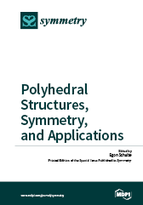Polyhedra
A special issue of Symmetry (ISSN 2073-8994).
Deadline for manuscript submissions: closed (31 August 2012) | Viewed by 68777
Special Issue Editor
Interests: discrete and combinatorial geometry; combinatorics; group theory; graph theory
Special Issues, Collections and Topics in MDPI journals
Special Issue Information
The study of polyhedra and symmetry has a long and fascinating history tracing back to the early days of geometry. With the passage of time, various notions of polyhedra have attracted attention and have brought to light new exciting classes of regular or other symmetric polyhedra including well-known figures such as the Platonic solids, Kepler-Poinsot star polyhedra, and Petrie-Coxeter sponge polyhedra, as well as the more recently discovered new regular or chiral skeletal polyhedra. This flexibility of the concept proves an important point --- polyhedra and symmetry have shown an enormous potential for revival! One explanation for this is the appearance of symmetric polyhedra in many contexts that a priori seem to have little apparent relation to symmetry, such as the occurrence of many figures in nature as crystals. In addition, their internal beauty appeals to the artistic senses and sparks the desire for a rigorous mathematical analysis and understanding of the figures themselves, as well as of their relationships with other areas of science.
This Special Issue of Symmetry features articles about polyhedra and symmetry. We are soliciting contributions covering a broad range of topics including: convex and non-convex polyhedra in spherical, euclidean, hyperbolic, or other spaces; maps and polyhedra on surfaces of higher genus; abstract polyhedra; polyhedra and symmetry groups; classification of polyhedra by transitivity properties of symmetry groups; regular polyhedra; various classes of highly-symmetric polyhedra, such as vertex-, edge, or face-transitive polyhedra, regular-faced polyhedra, and equivelar maps or polyhedra; space-filling polyhedra; polyhedra and crystallography; polyhedra in nature; polyhedra in art, design, ornament, and architecture; polyhedral models.
Prof. Dr. Egon Schulte
Guest Editor
Keywords
- regular polyhedron
- symmetry group
- classification by symmetry
- polyhedron on a surface
- abstract polyhedron
- crystals
- polyhedra in nature
- polyhedral models
- polyhedral design






